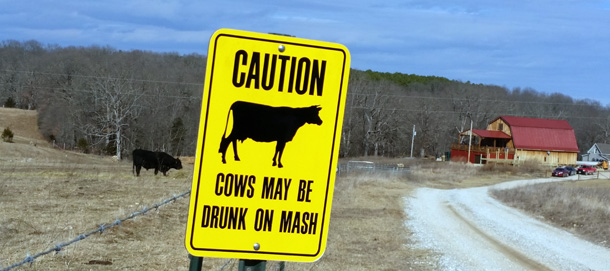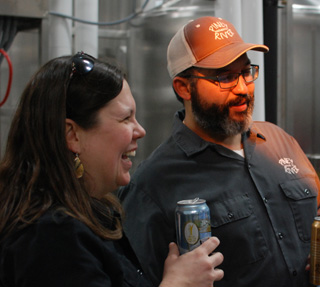The topic for The Session #136 today is Farmhouse Brewing. This is excerpted from the fourth chapter of Brewing Local, so was written n 2016.

Brian Durham was listening to National Public Radio on his drive to work one morning when he heard a report about preserving Pawpaw French, a disappearing dialect in the Ozarks. “I thought, ‘That’s it. We’re getting some pawpaws, we’re buying some French (saison) yeast,'” he said. Piney River Brewing was going to brew Paw Paw French Saison.
 Piney River is located on a farm five winding miles outside of Bucyrus, Missouri, because Brian and Joleen Durham live on the farm. They bought their house in 1997 and the rest of the 80 acres they live on five years later. They raise beef cattle on the property, but were too busy with the brewery in 2015 to get around to selling any. They feed spent grain to the cattle and a sign on the long gravel driveway leading to the brewery warns, “Caution, cows may be drunk on mash.”
Piney River is located on a farm five winding miles outside of Bucyrus, Missouri, because Brian and Joleen Durham live on the farm. They bought their house in 1997 and the rest of the 80 acres they live on five years later. They raise beef cattle on the property, but were too busy with the brewery in 2015 to get around to selling any. They feed spent grain to the cattle and a sign on the long gravel driveway leading to the brewery warns, “Caution, cows may be drunk on mash.”
They are not afraid of wordplay. When they renovated a 75-year-old barn that became their brewery tasting room they christened it the “BARn.” Each of the beers has a name that connects it to the Ozarks, and a story to back it up. Float Trip Ale, which won a gold medal in the 2014 World Beer CupSM American-Style Wheat Beer category, is the most obvious example. It makes perfect sense to those who frequent the Ozarks, but not necessarily to residents of New York or Los Angeles. Their description: “A float trip is the quintessential Ozark experience. A canoe, kayak, raft or tube and a pristine spring-fed Missouri stream creates a lasting memory of our wild and beautiful outdoors. Our hand-crafted blonde ale is the perfect accompaniment to your day on the river or to simply bring back float trip memories.”
Black Walnut Wheat is the best-selling beer. Seventy percent of the world’s harvest of black walnuts comes from trees growing wild in Missouri. They are processed in Stockton, about a 2 1/2 hour drive from the brewery, and about 45 percent of the crop will end up in ice cream. “They’ve got a lot of tannins, kind of bitter,” Brian explained, before Joleen added, “We think the heat (from being added during the mash) takes some of the astringency out and gives you some fruitiness.”
“One day I’m driving to the day job,” Brian said, explaining how the recipe for this beer evolved. “My thought was you could never use enough to make it shine in a heavier beer.” He decided to add a smaller amount to a relatively light beer, but to make it dark, using Midnight Wheat malt and Sinamar syrup. “Dark without the roasted flavor,” he said.
“This is one beer that would scale,” he said, when the discussion turned to brewing with local ingredients. The Durhams were brewing 10-gallon batches when they applied for a brewing license. They pushed a seven-barrel system to capacity in 2015, brewing 1,800 barrels before erecting a new building and installing a 15-barrel system with duel kettles that has the potential to produce 10,000 barrels a year.
“Getting to 10,000 is not a goal. Our goal is to be able to supply our distributors with a high quality product,” Brian said. “We spent the last two years undersupplying the markets we’re in. We want to brew beer in and about the Ozarks for the Ozarks.”
Pawpaws, on the other hand, would not scale. “You find it all around here in the river bottoms. Good luck getting them before the critters,” he said. They buy their pawpaws from a farm in Ohio.
Pawpaw French is far rarer than the Cajun French that is essential to the culture Bayou Teche is intent on preserving. It is considered a linguistic bridge that melds a Canadian French accent with a Louisiana French vocabulary. The French originally settled Old Mines, Missouri, around 1723, back when the area was part of Upper Louisiana. “My father and mother spoke French very fluently, but they didn’t want us to speak it because it (caused) such trouble in school,” said Cyrilla Boyer, a lifetime resident who was interviewed for the NPR report. She said in the 1920s and 1930s teachers would smack students’ knuckles for speaking any French in the classroom. Pawpaw French persisted in Old Mines primarily because the town is so remote.
Historian and musician Dennis Stroughmatt is Pawpaw French’s ambassador to the outside world. He first visited Old Mines back in the 1990s, and there were still hundreds of pawpaw speakers. “It’s like eating candy when I speak Pawpaw French. That’s the best way I can say. It’s a sweet French to me,” he said. He knows better than to expect the language to make a comeback, but hopes parts of it will survive, and that kids will learn some phrases, and will understand the area’s slogan: “On est toujours icitte,” which translates to, “We are still here.”
That part of the Ozarks is what interests the Durhams. “This area is considered economically depressed,” Joleen said. “We are creating value in the Ozarks with something we are making here. That means something to us.”
She grew up nearby. Brian is from New Jersey. The met at college in Pennsylvania, “I was going to live in the city and write,” she said. “I was leaving here and I was never coming back.”
It was a Saturday afternoon at the BARn. Inside, Scott Dill, superintendent at nearby Houston schools, was playing the guitar as part of a fundraiser for the Houston Education Foundation. Outside on the patio where Joleen and Brian were sitting with their son, volunteers were selling hot dogs and brats to raise money for the Houston Education Foundation.
She looked around. “I wouldn’t trade this,” she said. “I wasn’t thinking that when I was 18.”
I live near an island formerly named in the late 1600s after the founder of Arkansas, Tonti. New France from 1604-1760 was an arc from Nova Scotia down the St Lawrence, over to the Ohio and south along the Mississippi. I was also on the Board of the Rustico Acadian festival in PEI, a celebration based on their hiding through the expulsions of 1755-58. Fabulous when you learn about pockets living on.